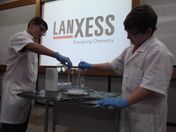Asia
EMEA

LANXESS Canada Contacts
Contact our Sites in Canada
Media Inquiries
General Inquiries
Please click here to e-mail LANXESS Canada with product inquiries and general requests.
Global Press Releases
2010-06-16
CAE tools for process simulation, structural component optimization and virtual testing
Customer service for cost-optimized lightweight construction
Design of a hybrid clutch pedal as a practical example
As one of the world’s leading manufacturers of polyamides and polyesters, LANXESS has extensive expertise in materials, the design of molded parts and manufacturing. The company applies this knowledge in projects undertaken with customers. When designing their components, the development partners are aided by CAE tools that precisely describe the forming process in the injection molding step, optimize the weight and properties of the component, and enable virtual testing of the component designs. The example of a clutch pedal made using a metal/plastic hybrid construction* demonstrates what LANXESS can achieve with these simulation tools. "We were able to propose a design that was then used as a prototype. It is stiffer in all load directions, considerably lighter and therefore more cost-effective to manufacture than previous versions of the component made of sheet steel," says Jürgen Knaup, head of Consumer Engineering Services in the Semi-Crystalline Products business unit.
A specific request from a customer required an existing sheet steel clutch pedal to be replaced with a hybrid construction design, while delivering the same – or improved – mechanical properties. This would save on both cost and weight. The initial design proposal using hybrid construction displayed comparable component properties, and already weighed considerably less. However, the plastic ribs were too close together, making it impossible to manufacture the component to this design. The task now was to achieve the highest possible level of stiffness with a minimal of material and as few ribs as possible, each placed in exactly the right position. However, the volume of the ribs in the component should not "occupy" more than 25 percent of the space available. Furthermore, the maximum wall thickness of the ribs should not exceed four to five millimeters. The ideal thickness was three millimeters, as this would allow the injection molded component to cool quickly in the mold and thus enable short, cost-effective cycle times.
With the help of optimization software, these basic conditions were used to calculate a proposal for ribbing that also took manufacturing issues into account. "The resulting component was already around 100 grams lighter than its sheet steel counterpart," explains Knaup.
Total weight saving of 300 grams
In the next step, the suggested optimization was translated into a detailed computational model in order to carry out virtual parts testing of the design. This revealed that even a standard polyamide with 30 percent glass fiber reinforcement was able to fulfill virtually all the requirements in terms of stiffness. In the y- and z-directions, the hybrid design is considerably stiffer – it is only in the x-direction that deformation is around 20 percent higher. This problem was resolved by using a polyamide with a higher glass fiber content of 60 percent. "Overall, the hybrid clutch pedal made is more than 300 grams lighter than the original steel model and also displays far better mechanical performance," concludes Knaup.
Integrative simulation – evaluating anisotropic properties
LANXESS is constantly working to refine its CAE tools so that it can offer even better customer service when it comes to component development. Through its own in-house development activities, for example, the company succeeded in linking process simulation and structural analysis using what is known as integrative simulation. As a result, it was possible to make internal component properties resulting from the manufacturing process – such as internal stresses and glass fiber orientation – available to subsequent simulations. Thermal expansion, strength and stiffness, for example, are very much dependent on the alignment of the glass fibers in the component. The more precisely these properties can be described in the computational model, the easier it is to develop a component that fulfills the relevant requirements in the best way possible. The simulation tool is now so sophisticated that it is being used successfully in the development of very complex components such as highly-integrated oil pans and front-end modules.
*Proprietary rights of third parties, such as patent applications, utility models or patents, and applicable legal regulations, such as the Protection of Inventions Act and Patent Act, must be observed.
#LANXESS is a leading specialty chemicals company with sales of EUR 5.06 billion in 2009 and currently around 14,300 employees in 23 countries. The company is represented at 42 production sites worldwide. The core business of LANXESS is the development, manufacturing and marketing of plastics, rubber, intermediates and specialty chemicals.
- Gallery




